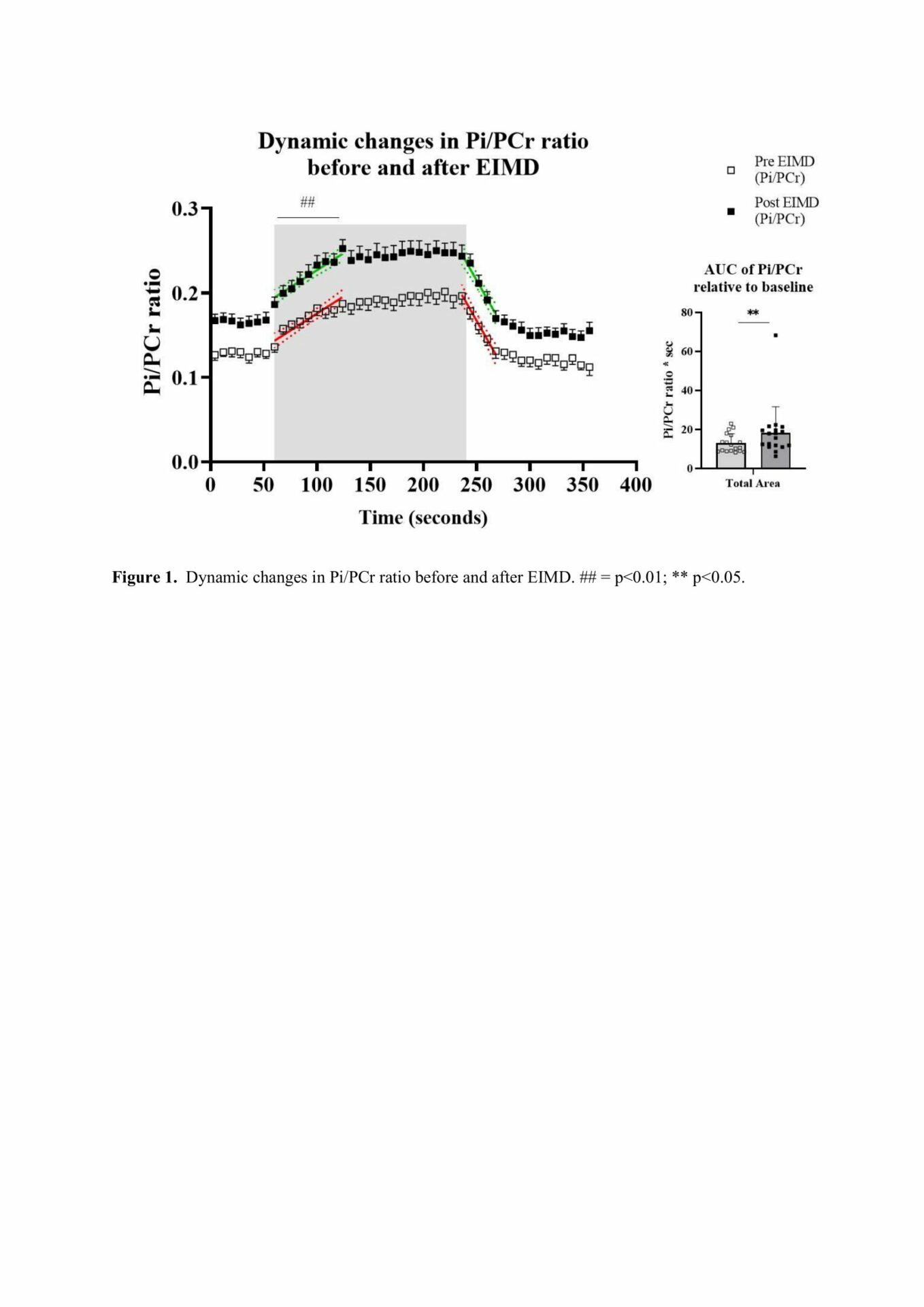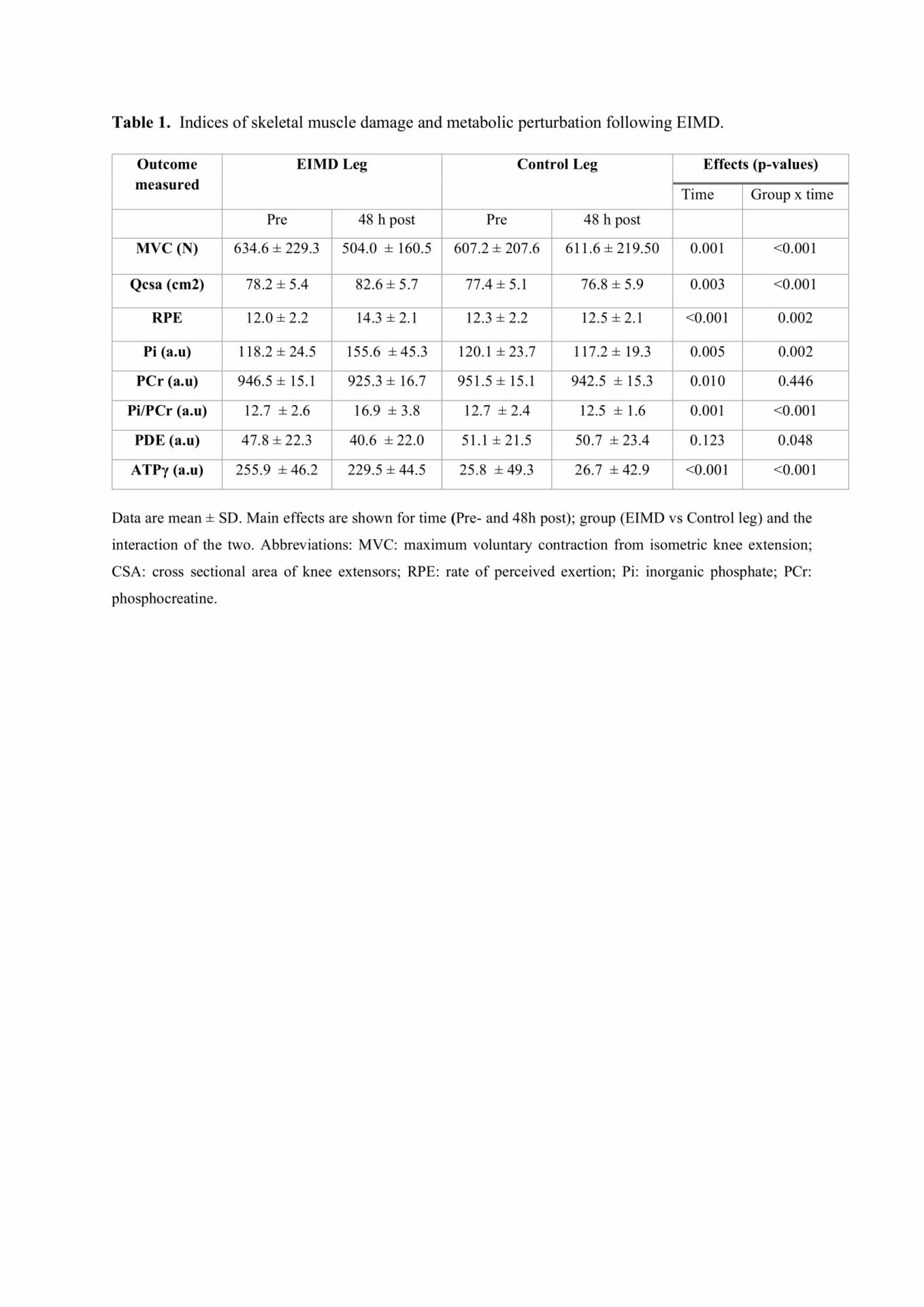Introduction. Exercise-induced muscle damage (EIMD) is particularly prevalent after unaccustomed eccentric contractions and is characterised by muscle weakness and soreness lasting several days (Armstrong, 1984). Previous studies using 31P magnetic resonance spectroscopy (MRS) found metabolic muscles abnormalities at rest with increased inorganic phosphate (Pi) and phospho-diesters (PDE) contents alongside reduced phosphocreatine (PCr) and adenosine triphosphate concentrations (ATP) (McCully et al., 1988). However, it is unclear if muscle metabolism differs during and after recovery from exercise of damaged muscles, and if changes are associated with perceived effort during exercise. Therefore, the aim of the present study was to investigate whether phosphorous metabolism changes with EIMD and whether changes are related to perceived effort during exercise.
Methods. Twenty physically active, healthy volunteers (age 23.4±4.0 years; BMI 23.6±2.4 Kg/m2; training hours 5.4±3.3 (mean ±SD)) were eligible and provided written, informed consent to take part in the study. Participants visited the laboratory for a familiarization session, the first (baseline) experimental session and the follow-up session 48h after baseline (48h EIMD). EIMD was induced by repetitive high-intensity eccentric single-leg extension contractions. Assessments at baseline and 48h after EIMD were implemented in both legs. A visual analog scale (VASSQ) assessed knee-extensors soreness and strength was assessed by single-leg maximal voluntary knee extension isometric contractions (MVC). Both thighs were imaged for quadriceps cross-sectional area (Qcsa) and 31P MRS at rest, during 3-min sustained isometric contractions and for 2-mins of resting recovery (Sleigh et al., 2016). Data between control and EIMD leg were analysed using two-way repeated measures ANOVA. The area under the curve (AUC) and differences for the kinetic changes (slopes) were determined in EIMD leg for Pi/PCr and PCr and were compared with a paired t-test.
Results. EIMD was evident at 48h from the significant time, leg, and time x leg interactions for MVC, Qcsa, and VASSQ (all p<0.002; Table 1). EIMD leg showed 18±4% reduction of MVC, 2.80 ± 0.04% increase of Qcsa, 20.8±0.1% increase in RPE, and 8267±1734% increase of VASSQ at 48h compared with baseline (all p<0.001). Resting PCr, Pi, Pi/PCr and ATPγ all showed significant effects of Time (all p≤0.010). Resting PCr values were marginally (-2.3%) lower at 48h compared with baseline for both the EIMD and control legs (effect of time p=0.010; time x leg interaction p=0.446). Significant time x leg interaction for Pi, Pi/PCr and ATPγ (all p≤0.002) was found, as values for Pi and Pi/PCr were higher and ATPγ was lower in the EIMD leg at 48 h compared with baseline, but control leg values for all these measurements remained unchanged over 48h (Table 1). Changes in RPE from baseline to 48h were significantly associated with changes to resting Pi, Pi/PCr and ATPγ only in the EIMD leg. Increased slopes from resting to exercise were found for Pi/PCr for EIMD leg, giving greater area under the curve (all p<0.01; Figure 1) but no changes were found for exercise-to-recovery slopes.
Conclusion: Our results suggest that EIMD changes muscle metabolism at 48h, affecting both resting and exercising muscle as well as perceptions of effort.


